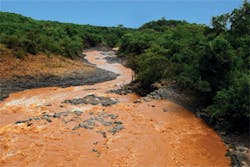Editor’s note: This article appeared in a previous issue of Erosion Control magazine.
To the untrained eye, it looks like an obvious problem that calls for a straightforward solution. When ocean waves and winds are attacking your prized shorefront property, you defend it–preferably with something that will resist the erosive forces as long as possible. But look a little closer and things don’t appear to be so simple.
For one thing, armoring your shoreline to preserve your land, your home, your view, and the beach might actually create more problems for your neighbor or others farther down the coast. What’s more, even the experts don’t agree on the best way to deal with shoreline erosion. In fact, some question the desirability of doing anything at all to fortify seaside dunes, bluffs, and cliffs. In the end, they say, nature will win out, so the only sensible thing is to move inland and let the beaches be. Then again, there’s the pesky matter of paying for the costly protection. Should some of the public’s money be spent to help private homeowners and businesses stem their losses?
Consider efforts in the past few years to control shoreline erosion on the southwest coast of the state of Washington. For decades, the beaches had been widening, until the early 1990s, when erosion started to occur. Since then, some $60 million has been spent to beef up a jetty protecting a harbor and build riprap sea walls to defend a beach town, a hotel-casino, and a highway from wave attacks. Yet critics claim such armoring of the shoreline only increases erosion. What’s more, they say the 14 dams constructed over the past 70 years on the Columbia River, which borders Washington on the south, have trapped the sand that once flowed to the mouth of the river. From there, ocean currents used to sweep it north to replenish these beaches. If that’s true, do you go back and tear out the dams? Research also indicates that waves battering this coast have grown bigger over the past 25 years. Any ideas on how to shrink them? One more thing: As it’s been doing for thousands of years, the sea level continues to rise. What do you do about that? Drain off some of the ocean? Despite the obvious threats to beach dwellers and commercial interests in southwest Washington, is it a problem that can even be solved?
A Dynamic Situation
Shorelines are flexible, dynamic works of nature. The best way to save them, say opponents of armoring, is to leave them alone. In the long run, they contend, it’s also much less expensive to abandon roads and houses or to move them inland rather than try to save them from receding bluffs and beaches.
Shorelines are temporary geological features continually shaped and changed by wind, waves, and tides. The beaches and dunes absorb some of the impact of direct wave attack to help defend coastal bluffs and cliffs.
Coastal areas are subject to various types of erosion. It can occur on an annual cycle as beaches expand and retreat in response to seasonal changes in weather. In winter, waves generated by storms might scour out large amounts of sand, leaving steep, narrow beaches. Much of this sand is transported offshore across the beach profile to form sandbars. During summer’s calmer weather, gentler waves wash this sand back onto shore, expanding the beach and building gentle slopes. Because of many variables, including climatic changes, the amount of sand movement at any one location isn’t consistent from one year to the next. Overall, however, if the littoral sediment inputs are more or less in equilibrium with the erosive outputs, these seasonal changes tend to average out over the long run. In this way, for example, sand eroded from beaches along the Atlantic shoreline of Florida and other East Coast states is replaced by sand brought in from farther north via nearshore wave-driven currents flowing southward.
Shoreline erosion can also be caused by variations or gradients in the longshore transport if more sand leaves a reach of beach than enters it. This can be a natural process at inlets and headlands. It can also be caused by dredging or dams on streams or rivers flowing to the sea, which reduce the amount of sand available to the beach.
What’s more, the shoreline can erode when the areas upland of the beach itself–the dunes, low bluffs, or high cliffs–erode. Erosion can also occur when the shoreline moves landward because of rising sea levels–a worldwide phenomenon underway since the last Ice Age ended 18,000–20,000 years ago.


